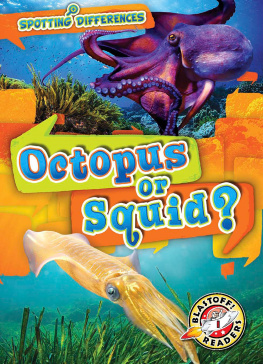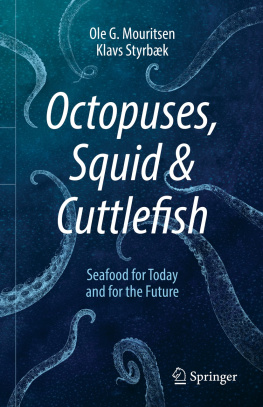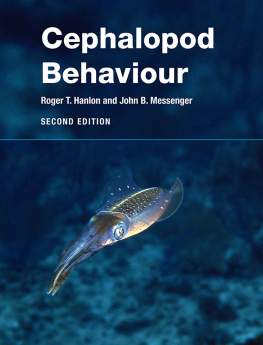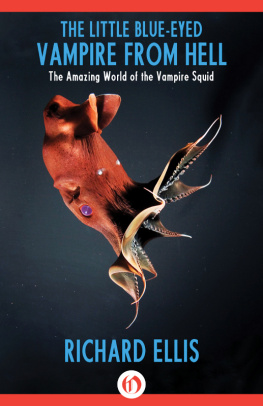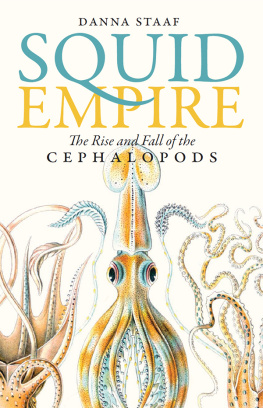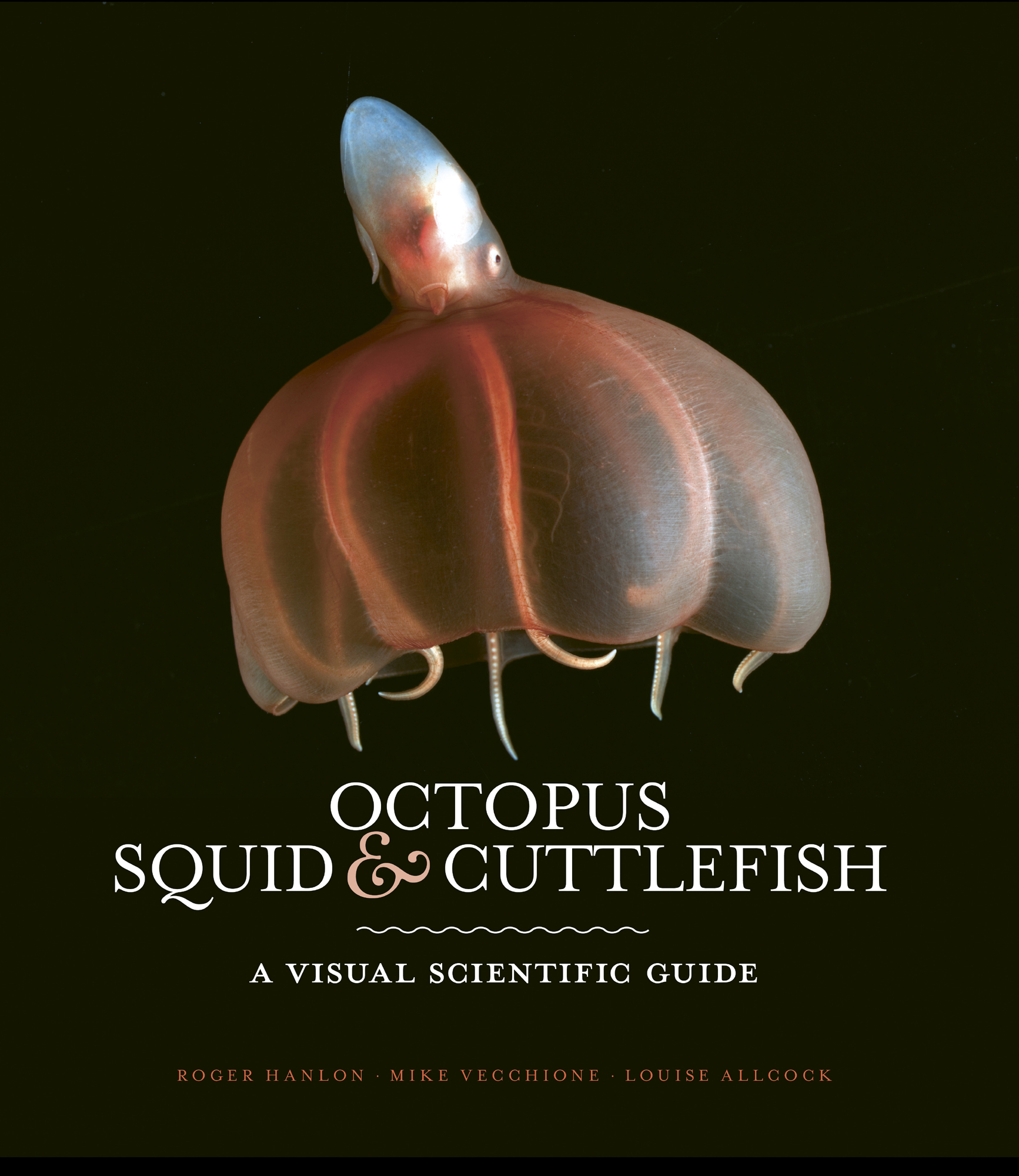OCTOPUS SQUID & CUTTLEFISH
A VISUAL SCIENTIFIC GUIDE
ROGER HANLON MIKE VECCHIONE LOUISE ALLCOCK

INTRODUCING THE CEPHALOPODS
BRAINY, COLORFUL, FAST, SOPHISTICATED, STRANGE, inspiringcephalopods have been on the planet for about 500 million years and have fascinated humans for thousands of years. Aristotle marveled at their mesmerizing color changes, and they were widely popularized in modern times by Jules Verne, Jacques Cousteau, and Peter Benchley. Scientists have studied them to advance basic and applied sciences, and the oceans depend on them for ecological balance and as a food source for many key predators. They are an evolutionary oddity, having developed the largest and most complex brains among invertebrate animals.
Octopuses, squids, cuttlefishes, and nautiluses are among the most beautiful animals on earth, and they have evolved large brains, keen senses, and complex behaviors that rival those of fishes and birds. They possess a very special quality known as Rapid Adaptive Coloration. That is, most of them can change their skin patterning and overall appearance in a fraction of a second to help deploy a wide range of adaptive behaviors such as camouflage, alarm, threat, predator escape, and mate attraction. To accomplish these visual illusions, they have developed elegant skin pigments and reflectors (or bioluminescent photophores) that produce colorful and jewel-like body patternseach pattern tuned to a specific function and ocean viewer. These animals are both attractive and enigmatic to the viewing public, yet there are considerable misconceptions about their abilities. This book presents factual and exciting descriptions that highlight their sophisticated behaviors and the key roles that they play in modern oceans, accompanied by stunning photographs of a wide range of species.
WHY A BOOK ON CEPHALOPODS?
Cephalopods are considered a charismatic animal group due to their colorful appearances, complex behaviors, and overall strangeness compared with most other animals. Some are huge (the giant squid) and some are very small and poisonous (blue-ringed octopus). Cephalopods occupy many oceanic niches and in some cases their numbers are massiveconsider that sperm whales feed almost exclusively on squids, and that their biomass alone is estimated by some to equal the total biomass of all human fisheries. Most cephalopod species occupy a central position in ocean food chains, being a primary food source for many marine mammals (whales, dolphins, seals), birds (penguins, petrels), and a vast array of fishes (including swordfishes, groupers, snappers, barracudas, eels). They are an ideal meal because they have few or no hard parts and are almost entirely muscle protein; indeed the cephalopods themselves are the subject of targeted fisheries worldwide. They are totally unlike any other animal groupinvertebrate or vertebrateand are worthy of scientific study in their own right. The public find them fascinating and weird, or simply like to eat them as a basic protein source.
In this age of biotechnology, engineers and biomedical scientists are looking to the natural world for bio-inspired approaches to solve problems of interest to human society, and cephalopods have attributes that society and industry would like to incorporate into modern devices. For example, soft, flexible yet strong robotic arms based on octopus arms would be welcomed by the medical community as well as search and rescue teams working in collapsed buildings. And who would not like to have the ability to change the color and pattern of their clothes, cars or other objects the way that cephalopods do?
On the other hand, there are some misconceptions about the real capabilities of cephalopods (what kind of smart are they?) and we attempt to put these into perspective with known scientific knowledge while simultaneously providing justice to their many fascinating attributes.
Octopus camouflage is extraordinarily effective and diverse. They tune the color and pattern to the background and even make their skin bumpy to resemble the 3D texture of the surrounds.
Even translucent squids like this one use their dynamically controlled chromatophores to enhance camouflage in the water column.
The blue-ringed octopus sometimes expresses its rings weakly for camouflage as in this image, but can also brighten them as a warning signal to approaching predators.
Cuttlefish can switch from camouflage to conspicuous signaling in one fifth of a second! Here the European cuttlefish is showing a conspicuous zebra pattern.
WHAT IS A CEPHALOPOD?
It is hard to imagine that an octopus or squid is related rather closely to chitons, snails, and oysters, but they are all in the Phylum Mollusca. Yet the Class Cephalopoda has evolved very differently from other classes of molluscs. Octopuses, squids, cuttlefishes, and nautiluses are invertebratesthat is, they have no backbone. This does not mean that they are simple or primitive or lower animals. As the reader may come to recognize in this book, cephalopods are sophisticated animals with a full array of sense organs, a complex brain, and highly diverse behaviors. Clichs and stereotypes about them abound, with varying degrees of accuracy.
Marine molluscs on steroids might be one glib way to describe cephalopods, yet this jocular analogy may be more truth than fiction since cephalopods have hormones that tend to super-charge some of their critical behaviors, such as malemale cuttlefish fights when they compete for a female mate (see chapter 4). Live fast and die young is a clich commonly used to describe cephalopods because they grow very fast (sometimes doubling their body weight every week in young stages) and many of them live only a year or less. Some cuttlefishes and squids increase their weight from less than an ounce (a few grams) to 1122 lb (510 kg) in 612 months (a few even faster). It takes humans 24 months to grow this large. Cephalopod growth hormones are far more powerful than those in other molluscs. Their extraordinary growth rates are in stark contrast to the slow growth and longer lives of other molluscs such as snails, clams, and oysters. This general life-history strategy is different from other invertebrates too, but is more in line with some groups of marine teleost fishes, which have sophisticated sensory systems, brains, and behaviors. Those fishes, however, typically have longer lives and more standard life histories. In short, cephalopods are just different from any other class of animals.


